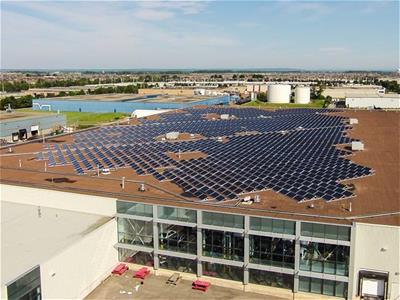Why Industrial Zones May Be More Eco-Friendly Than You Think
Aug 16, 2018
Written by Alice Clark, Freelance Sustainability Writer
Take any of the major routes out of Toronto, and you’ll quickly be thrust out of the downtown core of glass-plated high rises. Soon enough, the views flatten out into a checkerboard of suburban dwellings and industrial buildings.

As I regularly drive west of Toronto and up the 410 highway into Brampton, I’m fascinated by the kilometres of flat-roofed buildings, stacks of shipping containers storeys high, and long freight trains servicing the industrial parks. Ontario has the most manufacturing employees of any jurisdiction in Canada, and it’s easy to see that business is booming.
As someone who cares about the environment, I can’t help but notice the abundant grey of steel and concrete, blurred with chimney smoke, and the distinct lack of greenery. It doesn’t exactly give a hopeful picture of an eco-friendly district.
But there is more than meets the eye. Positive changes are taking place in industrial parks across the GTA.
Positive Change
Since 2008, businesses around the Toronto airport have been working together to make a greener impact through Partners in Project Green. The differences that they’ve made in waste reduction, team engagement, water conservation and energy efficiency are a great example of the innovation that can happen when businesses work together.
But making a positive difference for the environment isn’t limited to what goes on inside the four walls of a factory.
Industrial buildings house prime real estate that can be used for large solar projects, right on their roofs. Commercial scale photovoltaics are cropping up across Greater Toronto as building landlords collaborate with organizations like SolarShare. Of SolarShare’s 49 solar projects in Ontario, 20 of them are on rooftops, of which 15 are in the GTA. And as soon as the solar panels produce energy, they’re making a difference.
1. Better for the planet
SolarShare’s first project in Brampton was a collaboration with SotaWall, manufacturers of energy efficient glass. Their flat roof carries 2,300 solar panels. The energy produced goes directly back into the grid to fuel SotaWall’s head office and manufacturing, alongside other nearby industries. In just over three years, they’ve generated over 2.6 million kWh of energy, which is enough to provide power to nearly 100 homes for those three years.
2. Better for our communities
Solar energy is a safe, non-polluting energy source. The more we tap into the potential for renewable energy sources, the better our living conditions will be.
Solar panels installed on industrial buildings also benefit surrounding communities because they are rarely seen from street level, create no noise-pollution, and do not take up limited usable space in urban areas. A quick look at Google Maps shows the incredible potential still to be harnessed in flat roof space across Ontario.
3. Better for business
The rising trend of corporate social responsibility means businesses are increasingly looking to ways they can make a positive social impact. But collaboration with eco-friendly efforts must also benefit the financial bottom line.
Building landlords such as SotaWall immediately benefit from lease payments for the use of their roof space. Mike Brigham, SolarShare’s President adds, “the cost of solar continues to decrease, while all other energy sources except wind power continue to rise.”
In the future, businesses may also be able to take advantage of net metering to boost profits. With net metering, the building’s energy bill would be directly offset by the energy their roofs produce.
Looking Forward
Solar project collaborations are an excellent step on the journey of making industrial zones more eco-friendly. Net metering will hopefully motivate more building owners in industrial zones to look into partnering with solar organizations.
Perhaps we might also see the rise of collaborations such as Partners in Project Green, alongside eco-industrial parks, where industries work together to lower their environmental impact, improve their productivity, and pool their resources.
Written by Alice Clark, Freelance Sustainability Writer
